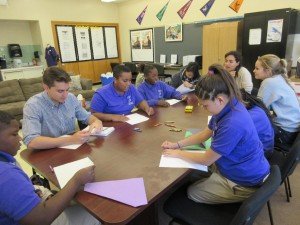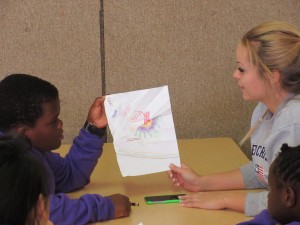Field Work : 1st Visit to School 2
Dec 7th, 2015 by jungg
September 9th, 2015 : First Visit
There are many stereotypes regarding the education and intelligence of minority groups, more particularly that of Latinos and African Americans. Some people believe that among these cultures there exist genetic imbalances that affect learning abilities and behaviors negatively. , However, there is no evidence that there exists some correlations between cultural background and academic performance. To further investigate and develop ways of addressing this problem, a group of five RPI design students, including myself, met with a class of 5th grade students in School 2 located in Troy, New York. We decided to spend our time with the students conducting an activity through which we could apply multiple learning techniques while also learn a little more about the students.
Since it is hard to get the attention from children around the ages of 10-12, especially if you are visiting a school environment for the first time, we decided to make “fun” another important aspect of our activity. Having a fun activity would allow us to grab the attention of the students while also giving them a good first impression. However, fun is a very subjective matter, so our team carefully took into consideration the different ways in which we could make our activity fun for the majority of the students while also maintaining school discipline.
We concluded on an activity where each of the students was handed a blank piece of paper and asked to draw something starting in one of the corners of the paper. After each child was done drawing, they had to fold the paper so that you could see part of the drawing but not enough to be able to tell what the drawing was. Then, they had to exchange papers with another student who was also done and develop a drawing based on what the precious student had left revealed. The students had to continue this process, exchanging with different students until each paper was almost full or until we decided to stop. Once we stopped, each student had to unfold the paper they were left with and come up with a story based on what they interpreted from the combination of drawings.
As we set up the instructions for our activity, we noticed there were many details we had to consider that would have an effect on the outcome of this activity. We thought about whether we should have given some constraints to what the students should draw but decided to leave it unspecified to test the children’s creativity and self-expression. We also hoped this would give us further insight on the student’s interests. Another consideration was whether we should have the children drawing in color or in pencil. We decided to let the children draw in color to make the activity more lively and attractive.
The activity was conducted with two different groups of students. The first group of students was made up by three African American boys and one African American girl. We began by introducing ourselves and explaining the activity to them. The children were very excited, patient, and listened well to the instructions. They were a little confused at first but they caught on quickly. In this group, all students were excited about drawing and looking forward to see the end result. One thing I noticed was that two of the boys had trouble making drawings that derived from the part of the previous drawing that was there. Another interesting aspect about the drawing part of the activity was looking at what kinds of things the students drew. In this group one of the boys drew basketballs and basketball hoops, another boy drew a beat box, and the other boy drew some trees. The girl drew birds, houses, and food items. When it was time to unfold the papers, the students were very excited and patient however they had trouble coming up with stories. The first boy, the one who drew the basketballs, volunteered to go first and was very excited; however, he was not able to come up with a story. He kept trying to say something and then said “no no no I can’t.” Our group did not push him to tell us a story. Instead, we asked if he would like for someone else to go first while he thought about it. The rest of the kids continued to make up a story however instead of coming up with a creative story that had a plot and a sequence, they were mostly listing the things that had been drawn. This could be due to the fact that many of the kids did not connect the drawings to the previous piece of drawing and to the fact that most of them drew very organized and concrete things.
When conducting the activity with the second group the dynamic was completely different. This group was composed of two girls, one African American and one white girl, and three boys, one who had broken an arm and two that were very loud (one with long hair and one with shorter hair). This group was hard to control since the beginning. They would not let us introduce ourselves or explain the activity; instead they kept asking us irrelevant questions and making fun of us. As we attempted to explain they kept interrupting with comments on everything, when I mentioned the word drawing, the girls were really excited and the two loud boys said that they hated drawing and didn’t even want to do the activity. The boy with the broken arm seemed annoyed by the other two boys and was very quiet and followed instructions well. The two loud boys continued to full around so we decided to start the activity with the kids who were willing to collaborate. The two loud boys kept commenting on everything everyone else drew and made it really hard to even finish the activity. Toward the end since we ignored many of their comments and payed attention to the people collaborating they decided to participate. Once we started telling the stories they were really interested but still disruptive. They would often say “no no that’s not this it is that” but overall payed attention. As a whole, this group was able to connect drawing to the previous ones better and had a combination of abstract and concrete drawings. They were also able to better develop eloquent stories that had an introduction, plot and ending. By the end of the activity there was not enough time for one of the loud kids to tell his story. Although he had been the most disruptive one and did not want to participate in the activity at the beginning, he was really upset he did not get to tell his story and would not leave. When I approached him I explained that if he would have been more collaborative we would have had time to hear his story. Since I did not want to disappoint him or discourage him from something he was interested, I offered to walk him back to his classroom and he could tell us his story along the way. This kid had a very imaginative and coherent story although he did not in his colloquial vocabulary. I was impressed. Before we left they all asked if we would come back.
It seems that overall the students enjoyed our activity. After meeting with the kids and actually testing our activity, I thought of many things we could have done differently to maximize our results or even make it so that the students have more to learn. One of the bigger issues to address for the next time is finding the best way to give instructions and explain the activity. I think students might have been overwhelmed by the multiple components in the activity. It might be a better idea to break the instructions into different components and give examples step by step. Another idea is to try this same thing but give different constraints. I wonder how the activity would look if we have the students draw only abstract things. Additionally, I thought of having the students write up a story instead of coming up and telling one on the spot. This can incorporate other critical learning concepts and the development of other types of learning. It is very interesting to observe and examine how kids learn and how different learning styles affect one another in the classrooms. I look forward to improving on our ideas and working closely with these children.

